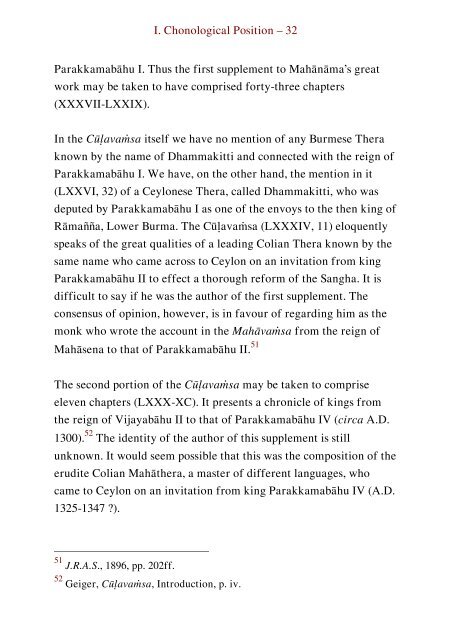On the Chronicles of Ceylon
A judicious appraisal of the various Chronicles that were written in Sri Lanka, assessing their chronology, literary and historical character.
A judicious appraisal of the various Chronicles that were written in Sri Lanka, assessing their chronology, literary and historical character.
- No tags were found...
You also want an ePaper? Increase the reach of your titles
YUMPU automatically turns print PDFs into web optimized ePapers that Google loves.
I. Chonological Position – 32<br />
Parakkamabāhu I. Thus <strong>the</strong> first supplement to Mahānāma’s great<br />
work may be taken to have comprised forty-three chapters<br />
(XXXVII-LXXIX).<br />
In <strong>the</strong> Cūḷavaṁsa itself we have no mention <strong>of</strong> any Burmese Thera<br />
known by <strong>the</strong> name <strong>of</strong> Dhammakitti and connected with <strong>the</strong> reign <strong>of</strong><br />
Parakkamabāhu I. We have, on <strong>the</strong> o<strong>the</strong>r hand, <strong>the</strong> mention in it<br />
(LXXVI, 32) <strong>of</strong> a <strong>Ceylon</strong>ese Thera, called Dhammakitti, who was<br />
deputed by Parakkamabāhu I as one <strong>of</strong> <strong>the</strong> envoys to <strong>the</strong> <strong>the</strong>n king <strong>of</strong><br />
Rāmañña, Lower Burma. The Cūḷavaṁsa (LXXXIV, 11) eloquently<br />
speaks <strong>of</strong> <strong>the</strong> great qualities <strong>of</strong> a leading Colian Thera known by <strong>the</strong><br />
same name who came across to <strong>Ceylon</strong> on an invitation from king<br />
Parakkamabāhu II to effect a thorough reform <strong>of</strong> <strong>the</strong> Sangha. It is<br />
difficult to say if he was <strong>the</strong> author <strong>of</strong> <strong>the</strong> first supplement. The<br />
consensus <strong>of</strong> opinion, however, is in favour <strong>of</strong> regarding him as <strong>the</strong><br />
monk who wrote <strong>the</strong> account in <strong>the</strong> Mahāvaṁsa from <strong>the</strong> reign <strong>of</strong><br />
Mahāsena to that <strong>of</strong> Parakkamabāhu II. 51<br />
The second portion <strong>of</strong> <strong>the</strong> Cūḷavaṁsa may be taken to comprise<br />
eleven chapters (LXXX-XC). It presents a chronicle <strong>of</strong> kings from<br />
<strong>the</strong> reign <strong>of</strong> Vijayabāhu II to that <strong>of</strong> Parakkamabāhu IV (circa A.D.<br />
1300). 52 The identity <strong>of</strong> <strong>the</strong> author <strong>of</strong> this supplement is still<br />
unknown. It would seem possible that this was <strong>the</strong> composition <strong>of</strong> <strong>the</strong><br />
erudite Colian Mahā<strong>the</strong>ra, a master <strong>of</strong> different languages, who<br />
came to <strong>Ceylon</strong> on an invitation from king Parakkamabāhu IV (A.D.<br />
1325-1347 ?).<br />
51 J.R.A.S., 1896, pp. 202ff.<br />
52 Geiger, Cūḷavaṁsa, Introduction, p. iv.


















